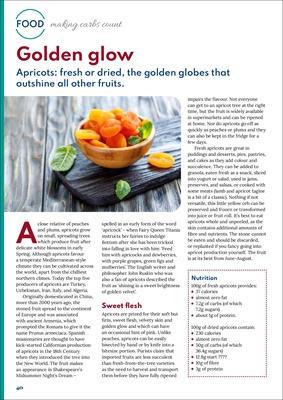
40
FOOD making carbs count
Golden glow
Apricots: fresh or dried, the golden globes that
outshine all other fruits.
A
close relative of peaches
and plums, apricots grow
on small, spreading trees
which produce fruit after
delicate white blossoms in early
Spring. Although apricots favour
a temperate Mediterranean-style
climate they can be cultivated across
the world, apart from the chilliest
northern climes. Today the top five
producers of apricots are Turkey,
Uzbekistan, Iran, Italy, and Algeria.
Originally domesticated in China,
more than 2000 years ago, the
stoned fruit spread to the continent
of Europe and was associated
with ancient Armenia, which
prompted the Romans to give it the
name Prunus armeciaca. Spanish
missionaries are thought to have
kick-started Californian production
of apricots in the 18th Century
when they introduced the tree into
the New World. The fruit makes
an appearance in Shakespeare's
Midsummer Night's Dream -
spelled in an early form of the word
'apricock' - when Fairy Queen Titania
instructs her fairies to indulge
Bottom after she has been tricked
into falling in love with him: 'Feed
him with apricocks and dewberries,
with purple grapes, green figs and
mulberries'. The English writer and
philosopher John Ruskin who was
also a fan of apricots described the
fruit as 'shining in a sweet brightness
of golden velvet'.
Sweet flesh
Apricots are prized for their soft but
firm, sweet flesh, velvety skin and
golden glow and which can have
an occasional hint of pink. Unlike
peaches, apricots can be easily
bisected by hand or by knife into a
bitesize portion. Purists claim that
imported fruits are less succulent
than fresh-from-the-tree varieties
as the need to harvest and transport
them before they have fully ripened
impairs the flavour. Not everyone
can get to an apricot tree at the right
time, but the fruit is widely available
in supermarkets and can be ripened
at home. Nor do apricots go off as
quickly as peaches or plums and they
can also be kept in the fridge for a
few days.
Fresh apricots are great in
puddings and desserts, pies, pastries,
and cakes as they add colour and
succulence. They can be added to
granola, eaten fresh as a snack, sliced
into yogurt or salad, used in jams,
preserves, and salsas, or cooked with
some meats (lamb and apricot tagine
is a bit of a classic). Nothing if not
versatile, this little yellow orb can be
preserved and frozen or transformed
into juice or fruit roll. It's best to eat
apricots whole and unpeeled, as the
skin contains additional amounts of
fibre and nutrients. The stone cannot
be eaten and should be discarded,
or replanted if you fancy going into
apricot production yourself. The fruit
is at its best from June-August.
Nutrition
100g of fresh apricots provides:
37 calories
almost zero fat
7.2g of carbs (of which
7.2g sugars)
about 1g of protein.
100g of dried apricots contain:
230 calories
almost zero fat
50g of carbs (of which
36.4g sugars)
12.8g start ????
10g of fibre
3g of protein